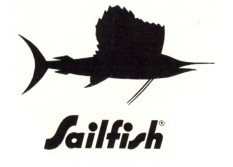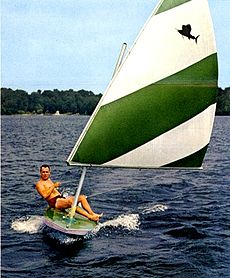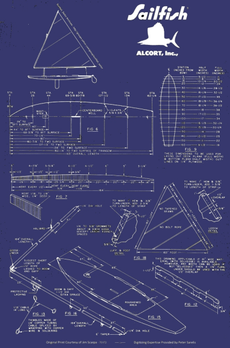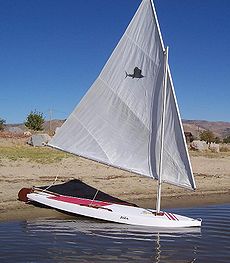.gif)
Sailfish (sailboat)
Encyclopedia
| LOGO | |||||
|---|---|---|---|---|---|
 |
|||||
|
|||||

Sailboat
A sailboat or sailing boat is a boat propelled partly or entirely by sails. The term covers a variety of boats, larger than small vessels such as sailboards and smaller than sailing ships, but distinctions in the size are not strictly defined and what constitutes a sailing ship, sailboat, or a...
is a small, hollow body, board-boat style sailing dinghy
Dinghy sailing
Dinghy sailing is the activity of sailing small boats by using five essential controls:* the sails* the foils ....
. The design is a shallow draft
Draft (hull)
The draft of a ship's hull is the vertical distance between the waterline and the bottom of the hull , with the thickness of the hull included; in the case of not being included the draft outline would be obtained...
, sit-upon hull carrying a lateen
Lateen
A lateen or latin-rig is a triangular sail set on a long yard mounted at an angle on the mast, and running in a fore-and-aft direction....
sail mounted to an un-stayed
Stays (nautical)
Stays are the heavy ropes, wires, or rods on sailing vessels that run from the masts to the hull, usually fore-and-aft along the centerline of the vessel...
mast
Mast (sailing)
The mast of a sailing vessel is a tall, vertical, or near vertical, spar, or arrangement of spars, which supports the sails. Large ships have several masts, with the size and configuration depending on the style of ship...
. This style sailboat is sometimes referred to as a "wet boat" because, with its minimal freeboard
Freeboard (nautical)
In sailing and boating, freeboardmeans the distance from the waterline to the upper deck level, measured at the lowest point of sheer where water can enter the boat or ship...
, the sailor often gets splashed by spray as the boat moves across the water. This flat top was known in some coves as the "ironing board of the ocean."
The distinctive low-aspect ratio
Aspect ratio (wing)
In aerodynamics, the aspect ratio of a wing is essentially the ratio of its length to its breadth . A high aspect ratio indicates long, narrow wings, whereas a low aspect ratio indicates short, stubby wings....
lateen sail gives the Sailfish a unique squat appearance compared with today's more familiar high-aspect ratio Bermuda rig
Bermuda rig
The term Bermuda rig refers to a configuration of mast and rigging for a type of sailboat and is also known as a Marconi rig; this is the typical configuration for most modern sailboats...
sailboats. First impression of this low profile rig might be that it sails awkwardly, however, the lateen sail plan shifts the advantage toward better performance in light air
Light air
A light air is a wind of force 1 on the Beaufort Scale, ranging in strength from 1 to 3 knots. Wind of this strength may not be felt on the skin, and leaves vegetation essentially undisturbed. It induces a drift in columns of smoke. At sea, a light air will raise small ripples on the surface of the...
and also contributes to it having good down-wind characteristics. The lateen sail along with its simple two line rigging
Rigging
Rigging is the apparatus through which the force of the wind is used to propel sailboats and sailing ships forward. This includes masts, yards, sails, and cordage.-Terms and classifications:...
made the Sailfish one of the easiest boats ever to learn fundamentals of sailing on.
Sailfish as the trade name for a board-boat first appeared in 1945. It was designed and built by Waterbury, Connecticut company Alcort, Inc., which took its name from founders Alex Bryan and Cortlandt Heyniger. They started out constructing iceboats and branched into small sailboats after being presented with a request to quote on a paddle board for the Red Cross. The project didn't pan out with the Red Cross, but Alex and Cortlandt felt an improved version might make a viable personal sailboat.
In 1949 LIFE Magazine
Life (magazine)
Life generally refers to three American magazines:*A humor and general interest magazine published from 1883 to 1936. Time founder Henry Luce bought the magazine in 1936 solely so that he could acquire the rights to its name....
published an article showcasing the Sailfish, calling it "the sportiest little sailing craft afloat". The write-up praised Alcort, Inc. and its Sailfish sailboat for adding a new and economical dimension to waterfront recreation. As a result of the national notoriety, Sailfish, and Alcort's later design, the Sunfish
Sunfish (dinghy)
The Sunfish sailboat is a personal size, beach launched sailing dinghy utilizing a pontoon type hull carrying a lateen sail mounted to an un-stayed mast....
, became so well-known their brand names became synonymous for nearly any board-style boat sporting the characteristic lateen sail.
Evolution

In the beginning, do-it-yourself boat builders crafted every piece, formed and assembled all the hardware from raw metal stock, and even sewed their own sail. Boats built in the Alcort shop received a sail obtained through Old Town Canoe Co., made by sailmaker Ratsey & Lapthorn. Eventually, Alcort had Ratsey-Lapthorn make a sail specifically for the Sailfish, eliminating the middleman and establishing Ratsey-Lapthorn as Alcort's regular sail provider, a status they retained until 1979.
Not long after introducing the Sailfish, Alcort decided to reach a broader market by supplying the boat in kit form. The kit contained a complete, ready-to-assemble boat in pre-cut pieces with the sail and all necessary hardware included. This provided a way for those who lacked the specialty tools and specialized skills of a boat-builder to construct their own Sailfish. From that point forward, the Sailfish could be purchased as a do it yourself
Do it yourself
Do it yourself is a term used to describe building, modifying, or repairing of something without the aid of experts or professionals...
kit, or fully assembled by Alcort. Sailfish were available in two models, the 11' 7½" Standard Sailfish and the 13' 7" Super Sailfish.
Alcort took the hollow body board-boat concept to the next level in 1959 when it introduced the Super Sailfish with a fiberglass
Glass-reinforced plastic
Fiberglass , is a fiber reinforced polymer made of a plastic matrix reinforced by fine fibers of glass. It is also known as GFK ....
hull. They named this model the Super Sailfish MK-II. This was the most popular model, and the one a majority of sailors remember as simply the "Sailfish".
Models


SPARS
SPARS was the United States Coast Guard Women's Reserve, created 23 November 1942 with the signing of Public Law 773 by President Franklin Delano Roosevelt. The name is a contraction of the Coast Guard motto: Semper Paratus and its English translation Always Ready...
were made from Sitka spruce and the sail was cotton. Historic photos show sails with as many as 10 panels and even small battens inserted. Sails in those days were lashed to the spars with line in the traditional manner instead of being attached by the plastic sail clips that became another familiar characteristic of this boat in later years. One of Alcort's first innovations for the Sailfish was to create a kick-up mechanism that automatically swung the rudder into a horizontal position for easy beaching. By the late 1950s the option of either a nylon
Nylon
Nylon is a generic designation for a family of synthetic polymers known generically as polyamides, first produced on February 28, 1935, by Wallace Carothers at DuPont's research facility at the DuPont Experimental Station...
or Dacron polyester sail in solid colors of red or blue became available to complement the previous white only sail.
In 1959 the fiberglass
Fiberglass
Glass fiber is a material consisting of numerous extremely fine fibers of glass.Glassmakers throughout history have experimented with glass fibers, but mass manufacture of glass fiber was only made possible with the invention of finer machine tooling...
13' 8" (4.2 m) hull Super Sailfish MK-II model was added to the lineup. The MK-II sported an aluminum mast and spars. The deck was available in colors of red, white, blue, green, and yellow with a five panel Dacron sail in alternating panel colors to match the boat’s deck color.
Not long after the fiberglass MK-II came onboard Alcort stopped supplying the factory assembled wood models. However, according to the sales brochures, the wood boats continued to be available in kit form long into the 1960s.
Alcort, Inc. sold their boat building company to AMF in 1969. AMF named their boat division for the founding Alcort Co., capitalizing on the tremendous name recognition Alcort, Inc. had built up over its 24 year history.
Little was done with the Sailfish design in the ensuing six years except to upgrade the rudder
Rudder
A rudder is a device used to steer a ship, boat, submarine, hovercraft, aircraft or other conveyance that moves through a medium . On an aircraft the rudder is used primarily to counter adverse yaw and p-factor and is not the primary control used to turn the airplane...
blade's shape in 1972 to the more streamlined
Drag (physics)
In fluid dynamics, drag refers to forces which act on a solid object in the direction of the relative fluid flow velocity...
design also used on the Sunfish. At the time of upgrade the bronze rudder hardware of the now waning Sailfish remained the same while the Sunfish was fit with a new design.
AMF discontinued the Sailfish in 1975.
The Sailfish successor, Sunfish
Sunfish (dinghy)
The Sunfish sailboat is a personal size, beach launched sailing dinghy utilizing a pontoon type hull carrying a lateen sail mounted to an un-stayed mast....
, continues to be built and is now found world wide.
Specifications
| Model | LOA | Beam Beam (nautical) The beam of a ship is its width at the widest point. Generally speaking, the wider the beam of a ship , the more initial stability it has, at expense of reserve stability in the event of a capsize, where more energy is required to right the vessel from its inverted position... | Sail Area Sail A sail is any type of surface intended to move a vessel, vehicle or rotor by being placed in a wind—in essence a propulsion wing. Sails are used in sailing.-History of sails:... | Hull Weight | Hull Material |
|---|---|---|---|---|---|
| Standard Sailfish | 11' 7½" (3.5 m) | 31½" | 65 ft.² (6.2 m²) | 82 lb (37 kg) | Wood† |
| Super Sailfish | 13' 7" (4.2 m) | 35½" | 75 ft.² (7 m²) | 102 lb (46 kg) | Wood† |
| Super Sailfish MK-II | 13' 8"‡ (4.2 m) | 36½"‡ | 75 ft.² (7 m²) | 98 lb (45 kg) | Fiberglass |
†The hull is planked with A-A exterior Douglas fir plywood or Harborite marine plywood.
Harborite, a plastic-surfaced fir plywood developed as an improvement on plain plywood.
‡ The additional inch is a result of the flange where the deck and hull bottom are bonded together as one.
External links
- Sunfish Sailor, Owner's Support Group - Archive Files

